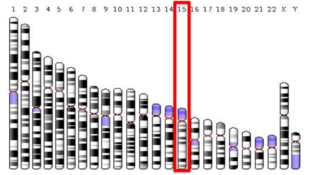
Transmembrane protein 268 is a protein that in humans is encoded by TMEM268 gene. The protein is a transmembrane protein of 342 amino acids long with eight alternative splice variants. The protein has been identified in organisms from the common fruit fly to primates. To date, there has been no protein expression found in organisms simpler than insects.

C8orf48 is a protein that in humans is encoded by the C8orf48 gene. C8orf48 is a nuclear protein specifically predicted to be located in the nuclear lamina. C8orf48 has been found to interact with proteins that are involved in the regulation of various cellular responses like gene expression, protein secretion, cell proliferation, and inflammatory responses. This protein has been linked to breast cancer and papillary thyroid carcinoma.

Ankyrin repeat domain-containing protein 24 is a protein in humans that is coded for by the ANKRD24 gene. The gene is also known as KIAA1981. The protein's function in humans is currently unknown. ANKRD24 is in the protein family that contains ankyrin-repeat domains.
TMEM156 is a gene that encodes the transmembrane protein 156 (TMEM156) in Homo sapiens. It has the clone name of FLJ23235.

PRR29 is a protein encoded by the PRR29 gene located in humans on chromosome 17 at 17q23.
Coiled-coil domain containing protein 180 (CCDC180) is a protein that in humans is encoded by the CCDC180 gene. This protein is known to localize to the nucleus and is thought to be involved in regulation of transcription as are many proteins containing coiled-coil domains. As it is expressed most highly in the testes and is regulated by SRY and SOX transcription factors, it could be involved in sex determination.

Transmembrane Protein 176B, or TMEM176B is a transmembrane protein that in humans is encoded by the TMEM176B gene. It is thought to play a role in the process of maturation of dendritic cells.
Uncharacterized protein Chromosome 16 Open Reading Frame 71 is a protein in humans, encoded by the C16orf71 gene. The gene is expressed in epithelial tissue of the respiratory system, adipose tissue, and the testes. Predicted associated biological processes of the gene include regulation of the cell cycle, cell proliferation, apoptosis, and cell differentiation in those tissue types. 1357 bp of the gene are antisense to spliced genes ZNF500 and ANKS3, indicating the possibility of regulated alternate expression.

Uncharacterized protein C12orf60 is a protein that in humans is encoded by the C12orf60 gene. The gene is also known as LOC144608 or MGC47869. The protein lacks transmembrane domains and helices, but it is rich in alpha-helices. It is predicted to localize in the nucleus.

Retrotransposon Gag Like 6 is a protein encoded by the RTL6 gene in humans. RTL6 is a member of the Mart family of genes, which are related to Sushi-like retrotransposons and were derived from fish and amphibians. The RTL6 protein is localized to the nucleus and has a predicted leucine zipper motif that is known to bind nucleic acids in similar proteins, such as LDOC1.
Chromosome 19 open reading frame 18 (c19orf18) is a protein which in humans is encoded by the c19orf18 gene. The gene is exclusive to mammals and the protein is predicted to have a transmembrane domain and a coiled coil stretch. This protein has a function that is not yet fully understood by the scientific community.

C17orf53 is a gene in humans that encodes a protein known as C17orf53, uncharacterized protein C17orf53. It has been shown to target the nucleus, with minor localization in the cytoplasm. Based on current findings C17orf53 is predicted to perform functions of transport, however further research into the protein could provide more specific evidence regarding its function.

Cilia and flagella associated protein 157 (CFAP157) also known as chromosome 9 open reading frame 117 (c9orf117) is a protein that in humans is encoded by the CFAP157 gene.

C15orf39 is a protein that in humans is encoded by the Chromosome 15 open reading frame 15 (C15orf39) gene.

Transmembrane protein 44 is a protein that in humans is encoded by the TMEM44 gene.

TMEM44 is a protein that in humans is encoded by the TMEM44 gene. DKFZp686O18124 is a synonym of TMEM44.

Chromosome 19 open reading frame 44 is a protein that in humans is encoded by the C19orf44 gene. C19orf44 is an uncharacterized protein with an unknown function in humans. C19orf44 is non-limiting implying that the protein exists in other species besides human. The protein contains one domain of unknown function (DUF) that is highly conserved throughout its orthologs. This protein is most highly expressed in the testis and ovary, but also has significant expression in the thyroid and parathyroid. Other names for this protein include: LOC84167.

Single-pass membrane and coiled-coil domain-containing protein 3 is a protein that is encoded in humans by the SMCO3 gene.

C1orf122 is a gene in the human genome that encodes the cytosolic protein ALAESM.. ALAESM is present in all tissue cells and highly up-regulated in the brain, spinal cord, adrenal gland and kidney. This gene can be expressed up to 2.5 times the average gene in its highly expressed tissues. Although the function of C1orf122 is unknown, it is predicted to be used for mitochondria localization.

Transmembrane protein 212 is a protein that in humans is encoded by the TMEM212 gene. The protein consists of 5 transmembrane domains and localizes in the plasma membrane and endoplasmic reticulum. TMEM212 has orthologs in vertebrates but not invertebrates. TMEM212 has been associated with sporadic Parkinson's disease, facial processing, and adiposity in African Americans.






















